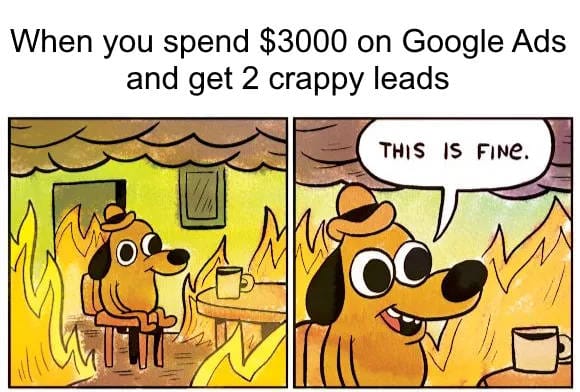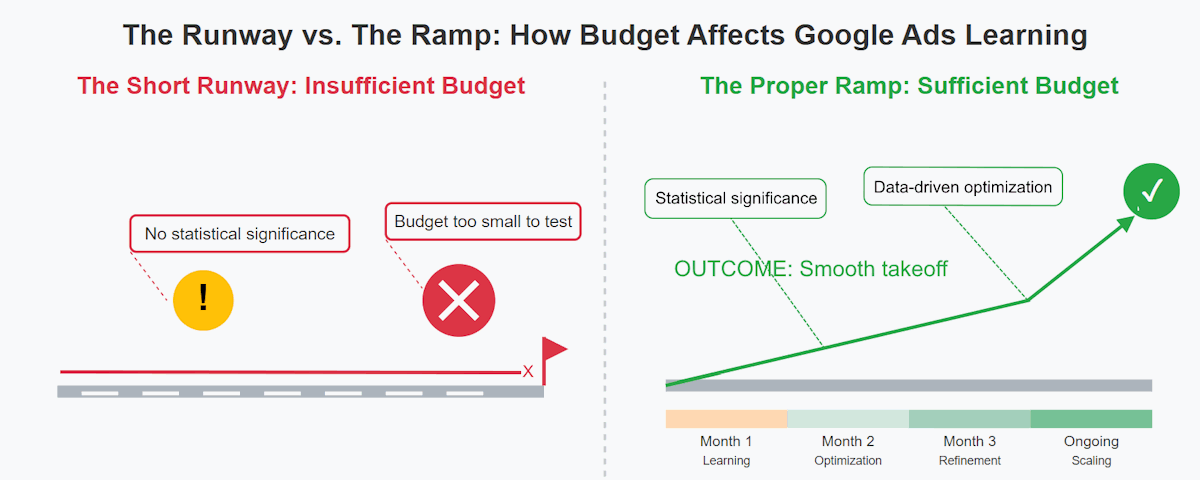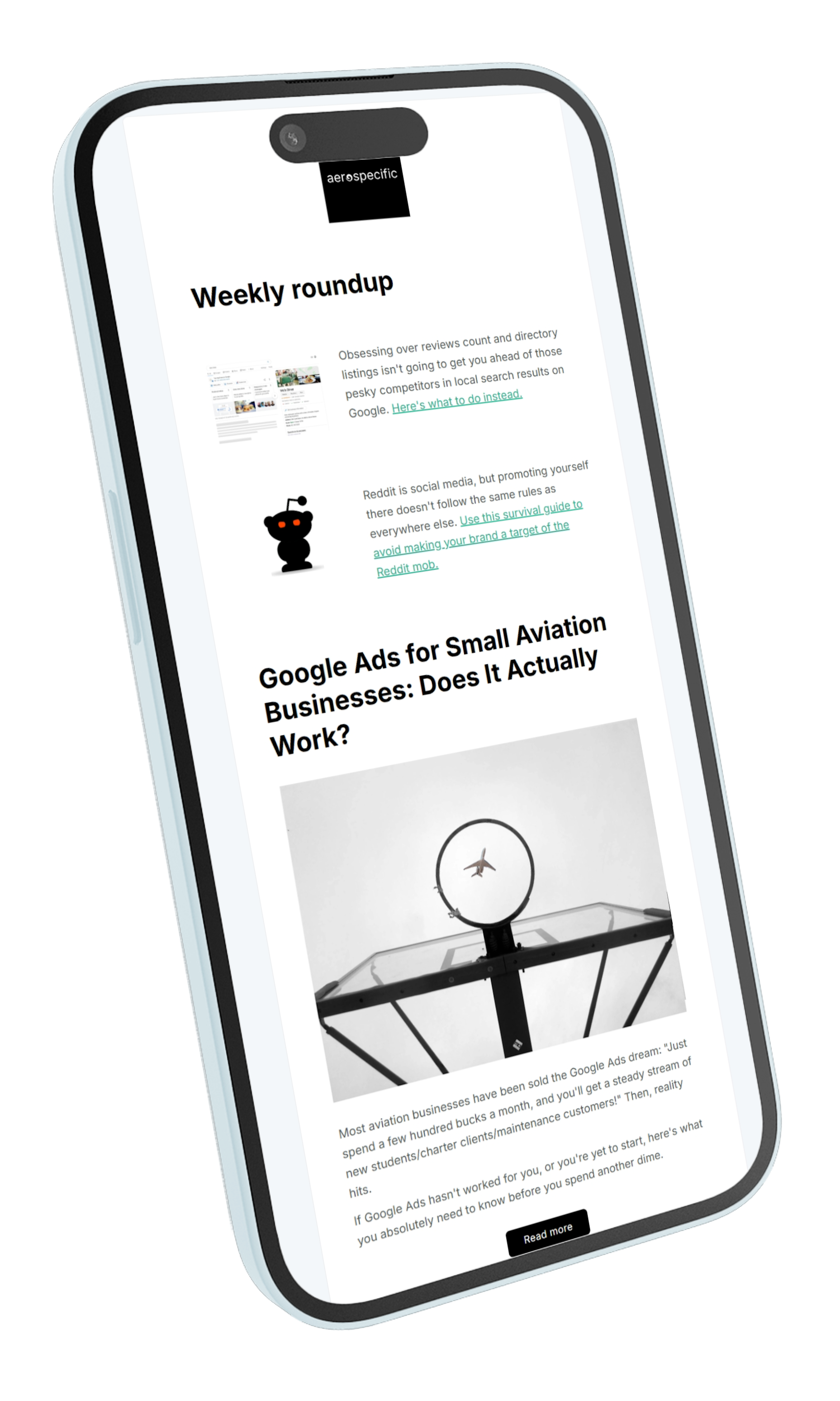Most aviation businesses have been sold the Google Ads dream: "Just spend a few hundred bucks a month, and you'll get a steady stream of new students/charter clients/maintenance customers!"
Then reality hits.
Three months and $3,000 (or more) later, you've got two mediocre leads and the sinking feeling that you’ve essentially set fire to your own money.

So, what’s the deal?
Does Google Ads actually work for small aviation businesses, or is it just a money pit with wings?
Let's cut through the noise and figure it out.
Making Google Ads work for your business
Google Ads is not a plug-and-play tactic.
It can work, but it needs a lot of calibration and fine-tuning.
I've personally witnessed three clear patterns in high-value service businesses like aviation:
- The winners don't just get more clicks — they convert better. They have landing pages specifically built for each service, not generic homepages.
- They focus their budget rather than diluting it. Instead of trying to advertise everything to everyone, they'll invest heavily in their most profitable services.
- They treat Google Ads as a system, not a switch. They understand the need for ongoing optimization and connect their ads to their sales process.
Think of Google Ads like an aircraft engine. When properly built, installed, and maintained, it delivers reliable power. When neglected or improperly set up, it's just an expensive deadweight that drags you down.
Google Ads readiness score: Is your business ready?
Before you spend a dime on Google Ads, let's determine if your aviation business is truly ready. This assessment will save you thousands in potentially wasted ad spend.
Give yourself 1 point for every "yes" answer.
1. Do people actually search for what you offer?
🔲 Your service has steady demand (flight training, maintenance, charters).
🔲When you search for your service, competitors are running Google Ads.
🔲Google suggests relevant phrases when you start typing your service (e.g., "flight school near me").
Scoring
- 🟢 Score 2-3: You have demand — Google Ads can work.
- 🟡 Score 1: Do deeper keyword research first.
- 🔴 Score 0: Search might not be the best channel — consider alternatives like Meta and YouTube.
This sounds obvious, but it's critical.
In the context of this article, we’re talking exclusively about Google Ads for search (not the rest of their ad network, like Display or Youtube).
And Google Search Ads work on a simple premise: people are already searching for your services. You're just making sure your business shows up.
If you’re selling something an amazing new cockpit gadget that nobody’s ever heard of, relying on search ads may not work.
2. Is your website ready?
🔲 Conversion tracking is set up and working
🔲 Pricing or service details are clear
🔲 Professional photos of aircraft / facility
🔲 "Book Now" or "Contact Us" button is visible above the fold
🔲 Phone number is immediately visible
🔲 Works perfectly on mobile
🔲 Pages load in under 3 seconds
Scoring
- 🟢 Score 5-7: You’re ready to run ads.
- 🟡 Score 3-4: Your site is leaking leads — fix it first.
- 🔴 Score 0-2: Google Ads will be a waste until your site improves.
I've analyzed hundreds of aviation business websites, and I'll be blunt: most are terrible at converting visitors into leads.
Even the best Google Ads campaign in the world will fail if it sends traffic to a website that doesn't convert. It's like having a perfect ILS approach down to a brick wall instead of a smooth runway.
3. Do you have the budget to get real results?
The figures below are a very generalized range. Your actual minimum viable budget depends on your geographic market, competition, and business type.
To figure out a realistic budget that’s valid for your business, check out my guide on how to calculate the minimum viable ad spend (MVAS) for your aviation business.
🔲 You’re able to wait 60-90 days for optimization.
🔲 You understand that $500/month spread thin won’t work.
🔲 You can commit at least $7,500-$15,000 over 3 months for testing.

Scoring
- 🟢 Score 2-3: You’re in a good position.
- 🟡 Score 1: Consider reallocating your marketing budget.
- 🔴 Score 0: Try other marketing methods first.
4. Do you have a system to handle leads?
🔲 You can handle 10+ new leads per month, at least initially.
🔲 You know how many leads turn into paying customers.
🔲 Scheduling is fast and easy.
🔲 You have a reliable system to follow up with leads.
🔲 You respond to inquiries within hours, not days.
Scoring
- 🟢 Score 4-5: You’re ready to scale.
- 🟡 Score 2-3: Leads may be slipping through the cracks — fix your system for follow-ups first.
- 🔴 Score 0-1: Google Ads may generate leads, but you won’t convert them.
Aviation sales cycles can be long.
People don't typically impulse-buy flight training or aircraft maintenance. They research, compare, and take time to decide.
Think of it this way: Google Ads is just the first leg of a cross-country flight. You still need to navigate the rest of the journey to reach your destination (a paying customer).
What your score means for you
🟢 Four greens: Ready for takeoff
Start with a focused campaign on your highest-value service:
- Use exact match and phrase match keywords initially
- Create specific landing pages for different audience segments
- Set up proper conversion tracking from day one
- Plan for weekly performance reviews
🟡 Three yellows: Pre-flight checklist incomplete
Focus on fixing your weak areas first:
- If website scored low: Redesign landing pages with clear CTAs
- If budget scored low: Consider starting with a more focused test
- If lead handling scored low: Implement a basic CRM system
- Reassess in 30-60 days after making improvements
🔴 One or more reds: Still in the hangar
Google Ads is likely to burn your budget at this stage. Consider more foundational marketing approaches first:
- Improve your website fundamentals
- Build an email list through content marketing
- Focus on local SEO and directory listings
- Look into partnerships with complementary aviation businesses
- Google Ads will still be around when you're ready
Key performance indicators that matter
Flying without instruments in IMC is a recipe for disaster. Running Google Ads without tracking the right metrics is equally dangerous for your marketing budget.
Here are the KPIs that actually matter for aviation businesses:
1. Cost per acquisition (CPA)
This is the total cost to acquire one paying customer through Google Ads. It's calculated as:
Total Ad Spend ÷ Number of New Customers = CPA
Your target CPA should be based on customer lifetime value. For example:
- Flight schools: If a typical student is worth $30,000, a $1,000 CPA is excellent (3.3% of LTV)
- Charter operators: If a regular client is worth $120,000 annually, a $6000 CPA is reasonable (5% of annual value)
- MROs: If a typical customer brings $8,000 in annual work, a $500 CPA is appropriate (6.25% of annual value)
This is your north star metric. Everything else is just a contributing factor.
2. Lead-to-customer conversion rate
This tells you how effectively you're turning inquiries into customers:
Number of New Customers ÷ Number of Leads × 100 = Conversion Rate
Industry benchmarks:
- Flight schools: 10-30% (from discovery flight to enrolled student)
- Charter operators: 10-30% (from quote request to booked flight)
- MRO facilities: 30-50% (from service inquiry to booked maintenance)
If your conversion rates are significantly lower, the problem isn't with Google Ads, it’s elsewhere — your offering, your pricing, your sales process, or something else.
3. Click-through rate (CTR)
This measures how compelling your ads are:
Number of Clicks ÷ Number of Impressions × 100 = CTR
Strong aviation CTRs typically range from:
- General aviation terms: 3-5%
- Specific services/aircraft types: 7-10%+
Low CTR usually means your ad copy isn't resonating with your target audience or you're targeting the wrong keywords.
4. Quality score
This is Google's 1-10 rating of your keywords and ads. Higher scores mean:
- Lower costs per click
- Better ad positions
- More traffic for the same budget
Aviation businesses should aim for quality scores of 7+ on their core keywords.
Here's what's important: These metrics are interconnected.
Improve your quality score, and your CPC drops.
Lower CPC means more clicks for the same budget. More qualified clicks means more leads. Better follow-up converts more leads to customers. All of this lowers your CPA.
It's a system, not just isolated numbers.
What to do if Google Ads didn’t work for you before
If you scored well on the assessment but previously had unsuccessful Google Ads campaigns…
1. Audit what went wrong
Common failure points in aviation Google Ads campaigns:
Keyword problems
- Using broad match without proper negative keywords
- Targeting terms too similar to consumer flight searches
- Missing model-specific maintenance terms
- Bidding on terms with no clear intent
Tracking problems
- Not tracking phone calls (critical for aviation businesses)
- No conversion tracking set up in Google Ads
- Unable to attribute customers to ad sources
Budget problems
- Spreading budget too thin across multiple campaigns
- Not adjusting bids based on device performance
- Spending too much on top-of-funnel keywords
- Failing to allocate budget based on best performers
Landing page problems
- Generic homepage that doesn't match search intent
- No clear next steps for visitors
- Forms requiring too much information upfront
- Missing trust elements specific to aviation (certificates, etc.)
2. Consider expert help
Sometimes it makes sense to bring in specialized expertise:
- Aviation marketing is specialized
- An expert can often identify issues quickly
- The cost of expertise is usually less than the cost of continued mistakes
(Feel free to drop me a message; I'm always happy to help, even if we don't work together.)
3. Try a completely different approach
If your current strategy isn't working, try:
- New landing pages with different messaging
- Different keyword targeting strategy
- Revised budget allocation
- Alternative campaign structures
Sometimes the difference between failure and success is surprisingly small. I've seen aviation businesses go from zero results to consistent leads with just a few strategic changes to their campaigns.
Next steps
Google Ads isn't right for every aviation business.
The businesses that succeed treat it as a system rather than a silver bullet. They invest appropriately, measure carefully, and optimize relentlessly.
Your assessment score gives you a clear next step. If you haven’t already, I highly recommend you use pen and paper and evaluate all your business against all of the aspects of the assessment with a critical eye.
Do that, and you'll have a clear roadmap ahead, and put yourself miles ahead of your competitors who are either avoiding Google Ads entirely or implementing it poorly.


